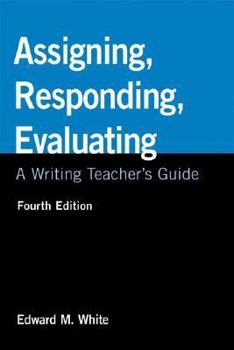Assigning, Responding, Evaluating: A Writing Teacher's Guide
Select Format
Select Condition 
Book Overview
Assigning, Responding, Evaluating: A Writing Teachers Guide helps you create writing assignments, evaluate student writing, and respond to that writing in a consistent and explainable way. This description may be from another edition of this product.
Format:Paperback
Language:English
ISBN:031243930X
ISBN13:9780312439309
Release Date:September 2006
Publisher:Bedford Books
Length:208 Pages
Weight:0.65 lbs.
Dimensions:0.5" x 6.0" x 8.9"
Related Subjects
Creative Writing & Composition Education Education & Reference Education & Training Language Arts Literary Criticism Literary Criticism & Collections Literature Schools & Teaching Study Study & Teaching Study Aids Study Skills Studying & Workbooks Writing Writing, Research & Publishing GuidesCustomer Reviews
2 ratings
Response to Chapters 1 and 2
Published by Thriftbooks.com User , 15 years ago
In our land of sprawling McMansions, through which we thrust out McTrucks in hot pursuit of the American McDream, those who could be the next greatest generation are, instead, barely able to churn out bland McPapers from their clogged up McBrains. In this book White asks us, as educators, to do something about this. He goes to some length showing us how to examine the failings of our own thinking and writing instruction (for one, there isn't enough of the "thinking" bit included in most instruction). In the first chapter of this book the author calls teachers of writing to task. In his view the effectiveness of a writing class depends on the teacher's ability to understand the acquisition of writing skills from a student's perspective, and teach to their needs. He covers many aspects of composition education,including skills in planning, revising, paragraph construction, and the sequencing of assignments, and compares what is commonly done to what is effective. His support for process-based teaching and logical sequencing of assignments resonated most with me; students need to learn the skills which serve as the basis for good writing, and each reading and writing assignment should serve as a foundation for the next. White also offers a large selection of assignments which can help students sharpen various discrete writing skills, and improve their thinking about their own thinking and writing. A few of these assignments, tailored to one's own class, could go a long way toward helping students actually improve their writing. In chapter 2, on writing assignments, White critiques the many ways in which teachers fail at writing essay questions, and provides guidance for writing teachers on how to best help their students gain the skills to do well on essay tests, even then the testing professor doesn't quite know what he or she is asking. The focus on the essay test worked well for this chapter. White could have gone on and on about an idyllic world in which all teachers write well-thought-out tests, and take the time to make themselves clear to the students. Instead, he kept to reality, and provided some guiding thought for writing teachers on how they might help their students cope with and master even the most poorly-written test. Skills such as devising one's own question based on the context of the test, fitting the scope of the response to the time limit, and planning thoroughly so that a rough draft reads like a second are all higher-order thinking tasks which will help students improve their writing skills overall.
Teachers: read theory, read theory, and read theory!
Published by Thriftbooks.com User , 15 years ago
What I appriciate most about my Masters of Ed program is its emphasis on paradigm shift. As I sit in the English dept. lounge and listen to teachers pass cynical (and certainly unqualified, also compassionless) value judgments and insults of students with Asperger's Syndrome and hard upbringings, as I sit through my graduate courses and watch my fellow grad students gossip in the middle of lectures by a kind and accommodating professor whose back has grown painfully worn, I realize that there is grave need for paradigm shift in the teaching world. This book encourages that. It doesn't sell compassion, per se. It's a book about proven strategies for teaching writing, all of which remind us that our students are humans. It's an accessible and worthwhile read, but what makes it worth keeping on an educator's shelf are the frequent gems of eye-opening wisdom. It challenges the notion of grading as incentive and reward and provides its own alternate methods. Do we really want students to work for a grade? Are we so concerned about competitive standards that we're more interested in distributing grades in such a way as to rate students rather than assess as an instructional technique? Yet at the same time, what does it say of the writing process when only the final product is assessed? How can we explicate the importance of open-minded revisions? And if we're truly dedicated to teaching the writing process, why are we pushing timed essays for college admission? White is not revolutionary in his contemporary theory on writing in secondary education. There is a plethora of literature available, all asking the same questions. I'd encourage all teachers and aspiring teachers to pick up three or four books on writing and reading instruction and keep abreast of education journals as articles are published. This book isn't so outstandingly better than any other reading in the field of education, but it lays out the writing process from beginning to end with readable language. It's a sound base for further research.






